Final report for FNE18-892
Project Information
The purpose of this project was to determine if specific value added products using herbs and flowers are profitable enterprises on a small diversified farm in New Jersey. A total of ten crops were trialed with the intention to collect data on stem counts and labor. Of the ten crops, seven were specifically grown for dried floral enterprises such as bouquets and wreaths. The remaining three could be included in dried floral products and sold as a dried herb or spice. After the labor and marketing tasks were complete, the net profit was calculated for each successful crop.
The net profit per crop is listed in order of highest to lowest: sorghum wreath, african blue basil as greenery for fresh cut flowers, african blue basil sold in fresh herb bunches, dried rye bunches, dried statice in a floral bouquet, and chile ristras. Additionally, the following crops were grown successfully, but their net profit was inconclusive due to at least one missing data point: seascape salvia, tricolor salvia, and black tip wheat. Lastly, two crops produce an insignificant amount of stems and therefore, were not deemed successful during this growing season: tanacetum parthenium and santa cruz oregano.
The conclusion from this is that the best proven profitable enterprises are sorghum wreaths and african blue basil as fresh greenery for cut flower production. The most complicated ornamental was chile ristras, though beautiful, is not profitable at this time.
The outreach for this project was held at the NOFA-NJ 2019 Winter Conference. The room was full of beginning and intermediate farmers, cooperative extension agents, home gardeners, and aspiring farmers. Five fact sheets were produced with an analysis of the productivity and potential profitability of African Blue Basil, Chile Ristras, Sorghum, Rye, and Statice. They will also be listed on the New Jersey Agricultural and Experiment Station Field and Forage Crops Fact Sheets and Bulletins.
Seasonal wreaths have the potential to be a profitable value-added product on small farms. We set out to analyze the production costs, required labor, marketability, and profitability of growing specialty cut flowers and grasses specifically for wreath production. Additionally, we compared the cost effectiveness of annual flowers and grasses to botanical material that already exists on our farm like herbs, cover crops, and hedge row. In doing so, we also noted the challenges of each method. We used crop enterprise budgets developed by Richard Wiswall (Cate Farm, Vermont) to understand the net profit per wreath. We sought to answer these questions:
How many stems are produced during a growing season?
How many stems are needed to make a dried floral wreath?
How many stems are unmarketable due to blemishes or breakage?
What is the net profit?
Is the enterprise profitable?
Determining whether or not wreaths can add to overall income and viability is important for all farmers in the ornamental business. Additionally, the ability to make business decisions with accurate and up to date information is essential. The conclusions and financial analysis can provide new knowledge to farmers who are interested in diversification, season extension, and job creation.
Seasonal wreaths, dried bunches and herbs, have the potential to be a profitable value-added product on small farms. I sought to analyze the production costs, required labor, marketability, and profitability of growing specialty cut flowers and grasses specifically for wreath production. Additionally, the cost effectiveness of annual flowers was compared to ornamental grasses and botanical material that already exists on the farm like herbs, cover crops, and hedge row.
When researching wreath production using dried flowers, herbs, and ornamental grasses, little information was found that provided growers with required stem counts. It would be extremely useful to know 1) On average, how many stems of a specific variety are needed to make a 8" or 14" in wreath and 2) How many marketable stems are produced on each plant per year. Rather than guessing the required row feet needed to make x number of wreaths, farmers could enter values into a mathematical equation and use this data for crop planning.
Growers in our region are making wreaths using dried flowers, herbs, branches, and other botanicals, but have not published material to share with fellow growers. Each grower must research varieties, growing information, and estimate crop plans which takes time and resources.
Resources like the second edition of Specialty Cut Flowers by Armitage and Laushman provides detailed information, but does not include all species we are interested in growing. Of the ten cut flower and ornamental grass species trialed, four are included, and of that four, only two list the number of stems/season. Furthermore, there are notations indicating differences in growing region, but no specific data for each hardiness zone.
The data collected will build upon the varietals suggested for wreath making and drying. It differs in that it will focus on production for growers specifically for wreaths ( stem counts/season and stem counts/wreath). The information distributed will focus on specifics for our growing region.
Site specific adaptations will revolve around our regular cut flower operation. Varieties grown specifically for wreaths will be in the same crop block so it is easy to compare productivity and determine whether or not a crop can easily fit into our production practices.
Determining whether or not value added products using dried material can add to overall income and viability is important for all farmers. Additionally, the ability to make business decisions with accurate and up to date information is essential.
Cooperators
- - Technical Advisor (Educator and Researcher)
Research
The project yielded successes and failures. Below you will find specific growing information for the varieties trialed. The crops that performed well and were sold at market as value added products are listed first with varieties that did not perform well following afterwards. At the end you can find the analysis process used to determine net profit for the enterprises.
Chile Ristra
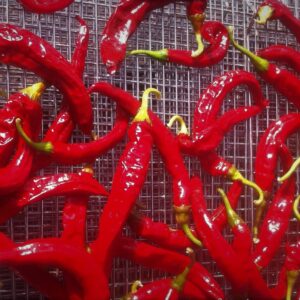
Procedure, Date:
- Seed peppers with a hand seeder in a strip tray and keep the tray on a heat mat in a greenhouse on April 8 (or 4 weeks before last frost).
- Water seedlings with a mist sprayer daily until germination for roughly 1 week.
- Remove seedlings from heat mat once germination occurs, April 15 (date can vary).
- Pot up peppers into 50 cell flat, May 1st (date can vary).
- Move peppers into a cold frame to begin hardening off process. May 7th (date can vary)
- Move peppers outside to harden off. May 10th (date can vary)
- Prep raised beds by drop spreading with soybean meal, then roto-tilling, and lastly making plastic beds. We used a tractor with the following implements: drop spreader, rototiller, plastic mulch layer with drip tape attachment. This date is weather dependent, we completed this task on April 30th, but it could be completed up until the day before transplanting.
- Using a manure spreader, lay leaf mulch. May 1st, (this date can vary but needs to be completed before transplanting.
- Transplant peppers by hand or using a water wheel transplanter. May 11th (date can vary, peppers can go outside once the forecast is clear of frost.
- Trellis peppers using stakes and twine. We use wooden stakes with tomato twine. We put out stakes on May 30th and trellised on July 3rd (date can vary, completed before fruit is mature)
- Water as necessary, May-October
- Monitor growth and health weekly, May-October
- Harvest hot peppers on the day of ristra production in September or October
- Make ristras in September or October (see fact sheet for detailed description of ristra making procedure).
- Mow dead plants after first frost, October.
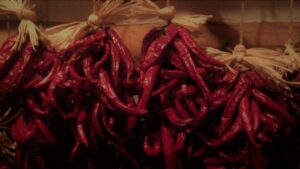
Finished chile ristras - Detrellis and unstake peppers, October.
- Lift plastic and drip tape, October.
- Pick up plastic and drip tape from field, October.
The following data was recorded throughout the growing season: number of peppers harvested, time required to complete each task, number of plants that died, bed feet, total ristras made, retail price, number or ristras sold, unmarketable chiles harvested, unmarketable chiles left on the plant, number of green chiles on the plant at time of first frost, and cost of seed, tractor use, plastic mulch, drip tape, and leaf mulch.
Sorghum Wreaths and Bunched Stalks
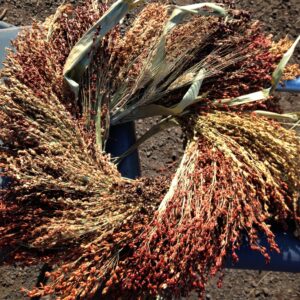
Procedure, Date
- Drop spread soybean meal, rototill soil, and bed form with bare ground bed former, June 29th (weather dependent)
- Direct seed sorghum with Earthway Seeder using plate # 18112 and walk two passes on each row. If plate # 18103 is available, that can plate also be used. July 5th
- Weed as necessary July
- Harvest Sorghum stalks (5' tall) starting in early October for the next four weeks. Wrap bunches of 5 stalks with jute twine to sell.
- Harvest Sorghum tassels, trim at the base of the stem. November 1-20
- Make wreaths using a wreath clamp and a clamping tool. Use 3-5 tassels per clamp. Accents of rye, wheat, or any decorative leaf can be added to the wreath. November 1-20.
The following data was recorded throughout the growing season: bed feet planted, number of plants, unused bed feet that was planted, all labor points, number of wreath sold, price per wreath, and unmarketable stems.
Statice
Procedure, Date
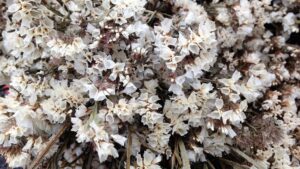
- Greenhouse seeding using 128 cell flat, March 27.
- Water flats daily March and April.
- Drop spread using soybean meal, rototill soil, and bed form with a plastic mulch layer, April 30th (weather dependent).
- Transplant flowers by hand, 3 rows, 1 foot in-row spacing, May 12th
- Pinch florets, throughout June
- Weed aisles and planting holes, June-August
- Harvest and bunch statice stems in the field with a rubber band. Average about 20 stems per bunch, August - September
- After harvesting, hang bunches to dry in a well dark, dry, and well ventilated location, August-September.
- Let plants dry for about three weeks.
- Wrap jute twine at the base of each bunch to add value. Pluck off any undesirable flowers or stems in each bunch.
- Lift plastic and drip tape, end of season
The following data was recorded throughout the growing season: bed feet planted, total number of plants, number of plants that died, marketable stems, unmarketable stems, number of stems harvested for each plant, total bunches made, total bunches sold, price per bunch, and all labor.
African Blue Basil

Procedure, Date
- Order basil plants, March
- Drop spread with soybean meal, rototill soil, and bed form using a plastic mulch layer, April 30 (weather dependent).
- When basil arrives, unpack from original media and pot up into individual 3.5" pots, early May
- Transplant by hand into plastic, 3 rows, 1 foot in-row spacing, May 15th
- Weed planting holes and aisles as needed, June-September
- Pinch flowing tops of plants end of May-mid June
- Harvest stems as needed late June-first frost. When harvesting, bunch basil stems in the field with a rubber band averaging 10 stems per bunch or 0.33lbs
- For dried bunches, hang bunches in a dark, dry, well ventilated place after harvesting.
- When dried, remove leaves over a clean crate or bucket without holes at the bottom. Gather leaves and pack in a food safe storage jar with leaves.
- Lift plastic and drip tape, end of season.
The following data was recorded throughout the growing season: labor, stems harvested, bunches made, price per bunch, broken stems, bed feet, number of plants, number of plants that died, weight of bunches, bunches sold, and number of stems in a bouquet.
Rye
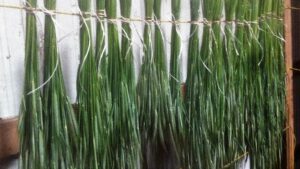
Procedure, Date
Cover Crop:
- Seed rye in August or September of the previous year with a broadcast seeder or grain drill.
- Harvest rye in April or May when the seed head begins to form but is not mature.
- Bunch rye stems in the field with an average of 45 stems per bunch. Hang to dry in a dark, dry, and well ventilated location.
Ornamental Rye:
- Drop spread soybean meal, rototill soil, and bare ground bed form, June 29th
- Seed rye with Earthway seeder using plate #18112. More than two passes on each row are required with this plate. If plate #18103 is available, use this instead.
- Weed as necessary July - September
- Harvest rye and bunch in field while seed heads have formed and are mature, September.
- Hang rye to dry in a dark, dry and well ventilated location.
Black Tip Wheat

Procedure, Date
- Drop spread soybean meal, rototill soil, and bare ground bed form, June 29th
- Seed wheat with Earthway seeder using plate #18112. More than two passes on each row are required with this plate. If plate #18103 is available, use this instead.
- Weed as necessary July - September
- Harvest wheat and bunch in field while seed heads have formed and are mature, September.
- Hang wheat to dry in a dark, dry and well ventilated location.
Vegmo Sunny Balls (Tanecetum parthenium), Seascape Salvia (Salvia farinacea), and Tricolor Salvia (Salvia viridis) did not produce enough quality flowers to include their stems in wreaths or other value added products. Each variety was grown using the same methods as Statice above.

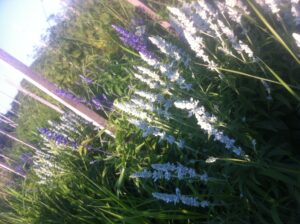
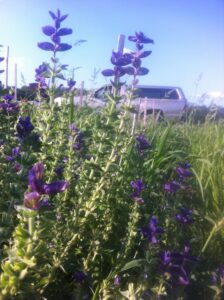
Analysis Process
Cost of labor
All data was entered into a Microsoft Excel spreadsheet for analysis. To determine cost of labor, enter all activities and the time required to complete each task in hours. Multiply each line by the hourly wage of the individual who completed the task. This number is the cost in dollars for each task. To find total cost of labor, add together the cost in dollars each for each task.
Examples:
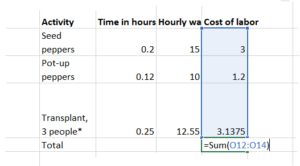
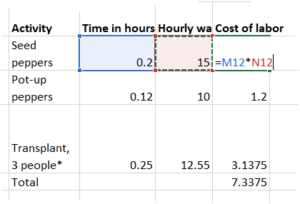
*When more than one person completed a task as in the transplanting activity above, the time in hours is multiplied by the number of people involved in the activity. An average of their hourly wage is calculated for the 'hourly wage' column. A more accurate method is to record each time separately and add them to the spreadsheet as individual line items.
Cost of Materials
List all material expenses used in production and their cost. For items like drip tape and plastic that are used once and purchased in bulk, calculate the exact cost using the following calculation: (price of bulk item x bed length planted in specific crop)÷(total length of bulk item).
Example:
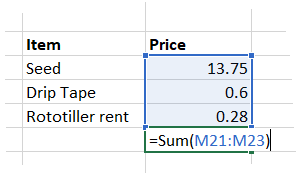
($147 x 31 bed feet) ÷ (7546 feet) = 0.603
This formula only works if the unit of length is the same for the bulk item and crop length.
Include the amortized costs of capital expenses like tractors and implements. Below, this is listed as rent.
General overhead, cost of land, and administrative costs can also be included in this category.
After all the items are listed, add each line together to find your total material expense.
Cost of Production
Once you've calculated total cost of labor and cost of materials, add these two numbers together and you now have the total cost of production for a crop.
Cost of labor + Cost of materials = Cost of production
Gross Profit
Calculating gross profit by multiplying the number of an item sold by the price.
Gross Profit= (number of bunches sold) x (price)
Net profit can only be calculated after all of the above steps are completed. Net profit is the amount of money a crop made after all the expenses are taken into account. Net profit is calculated by subtracting the cost of production from gross profit.
Net Profit = (gross profit) - (cost of production)
With this number, one can determine whether or not the enterprise is economically viable. A positive number indicates the enterprise made money and a negative number indicates the enterprise lost money.
Eleven varieties that showed potential for it's drying characteristics and ease of growing were trialed. For each variety I counted the total number of stems harvested and the number of marketable stems produced by each plant. For chili peppers, the number of peppers was counted. Additionally, the net profit for each variety that sold at market was calculated.
Though I set out to know the number of stems needed for floral wreaths, I was unable to capture the full extent of that data due to poor weather and growing conditions throughout the season. In December 2018, the New Jersey State Climatologist announced that it was the wettest year on record. It also proved to be the second warmest August and third warmest September (Office of the New Jersey State Climatologist, New Jersey Agricultural Experimental Station). These conditions led to flooding in the aisles, increased stress on plants, uneven germination, and blossom defects.
Due to the poor growing conditions, a few varieties that were grown for their use in floral wreaths either did not produce flowers or produced flowers that had undesirable characteristics when dried (browning, deformed seed head or blossom). When situation was realized in August, I continued to record data and marketed varieties that performed well in floral bunches rather than wreaths. In the case of sorghum we were able to note stem counts for wreaths and it is denoted alongside the results.
Below you will find the results for each variety grown and notes about performance. All net profit calculations were determined based on labor costs at $20/hr.
African Blue Basil
Latin Name: Ocimum kilimandscharicum x Ocimum basilicum
| Bed Feet | Row Feet | # plants | # plants died | |
| African Blue Basil | 10 | 28 | 28 | 0 |
| Enterprise | Labor(min) |
Total bunches/stems /weight | Total bunches sold # |
Price $ |
Gross Profit $ |
Cost of Production $ |
Total Net Profit $ |
Net profit per bunch $ |
Average bunch weight |
| Fresh basil bunch | 67.28 | 20 | 17 | $3/bunch | 51 | 22.42 | 28.57 | 1.68 | 0.34 lbs |
| Dried Basil | 108.05 | 0.33lbs, 5.44oz | NA* | $3/oz or $48/lb | 15 | 36.016 | -21.01* | -- |
-- |
| Basil for Bouquet | 53.51 | 215 | 215 | $0.3/stem | 64.5 | 30.73 | 47.33 | 0.22 | -- |
*Dried basil could not be sold at market because it was not dried and packaged in a commercial kitchen. It is important to look up Food Safety and Cottage Food Laws in the respective state. The projected net profit was calculated with the assumption that all five containers sold.
Growing Notes:
- Seed is sterile, live plants need to be purchased, organic options available
- Multiple harvest from same plant. Stems grew back in three successions when planted in May.
- Not frost tolerant
- Live plants ordered from The Tasteful Garden
Seascape Salvia
Latin Name: Salvia farinacea
| Bed Feet | Row Feet | # plants | # plants died | Total Stems Harvested # |
Max # stems harvested on one plant | Minimum # stems harvested on one plant | |
| Seascape Salvia | 16 | 32 | 23 | 2 | 428 | 51 | 0 |
| Labor (min) |
Marketable stems # |
Unmarketable Stems # |
Broken Stems # |
Total stems # |
Average # stems/plant | Cost of production $ |
| 169.27 | 382 | 27 | 19 | 428 | 18.6087 | 56.42 |
| STEMS PER PLANT | ||||||||||||
| SS1 | SS2 | SS3 | SS4 | SS5 | SS6 | SS7 | SS8 | SS9 | SS10 | SS11 | SS12 | |
| 27 | 51 | 33 | 19 | 1 | 17 | 21 | 13 | 21 | 22 | 22 | X | |
| SS13 | SS14 | SS15 | SS16 | SS17 | SS18 | SS19 | SS20 | SS21 | SS22 | SS23 | SS24 | SS25 |
| 4 | 27 | 18 | 6 | 32 | 8 | 12 | 24 | 15 | 10 | X | 19 | 6 |
x denotes plant died
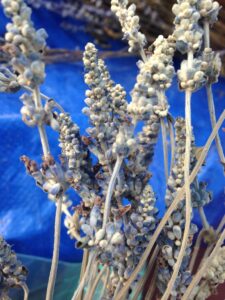 Growing Notes:
Growing Notes:
- There was a wide variation in number of stems produced per plant.
- Stems are thin and fragile. They easily break while stripping leaves during harvest and handling them while dried.
- Slow to harvest
- Short stem length
- Performed well despite poor growing conditions.
- If growing for dried flowers, it is important to harvest before the blossoms open and petals emerge. Petals will turn brown when dried. (See photo below)
- Hue remains vibrant when dried
- Seed source: Fedco Seeds
QIS White Statice
Latin Name: Limonium sinuatum
| Bed Feet | Row Feet | # plants | # plants died | Total # stems harvested |
Broken stems # |
Average #Stems per plant | Max# stems cut from one plant | Min #stems cut from one plant | # live plants that did not produce stems |
# Stems not marketable due to cut date |
|
| QIS White Statice | 18 | 56 | 49 | 2 | 222 |
1 |
4.53 | 32 | 0 | 10 | 6 |
| Enterprise | Labor (min) |
Total bunches made # |
Total #bunches sold | Price per bunch $ |
Cost of production $ |
Gross Profit $ |
Total net profit $ |
Net profit per bunch $ |
| Bunched Statice | 139.33 | 7 | 3* | 7 | 46.44 | 21 | -25.44 | -8.48 |
*3 bunches sold as of 12/30/18, we project all 7 bunches will sell through the winter and net profit would therefore be $2.56 and net profit per bunch would be $0.36
| Q1 | Q2 | Q3 | Q4 | Q5 | Q6 | Q7 | Q8 | Q9 | Q10 | Q11 | Q12 | Q13 | Q14 | Q15 | Q16 | Q17 |
| 4 | 4 | 4 | 19 | 2 | 0 | 8 | 1 | 13 | 1 | 0 | 3 | 0 | 0 | 0 | 2 | 0 |
| Q18 | Q19 | Q20 | Q21 | Q22 | Q23 | Q24 | Q25 | Q26 | Q27 | Q28 | Q29 | Q30 | Q31 | Q32 | Q33 | |
| 32 | 3 | 1 | 2 | 13 | 9 | 13 | 13 | 5 | 1 | 1 | 2 | 13 | 5 | 12 | 2 | |
| Q34 | Q35 | Q36 | Q37 | Q38 | Q39 | Q40 | Q41 | Q42 | Q43 | Q44 | Q45 | Q46 | Q47 | Q48 | Q49 | |
| 4 | 1 | 2 | 0 | 5 | 0 | 0 | X | X | 0 | 2 | 6 | 2 | 1 | 8 | 3 |
x denotes plant died
Growing Notes:
- Performed well despite poor growing conditions
- Tall and thick stems
- Easy and quick to harvest
- Dried well
- Stems are more fragile when dried
- Vibrant hue remains when dried
- Seed source: Fedco Seeds
Vegmo Sunny Balls
Latin Name: Tanecetum parthenium
| Bed Feet | Row Feet | # plants | # plants died | Total # Stems Harvested | |
| Tanacetum parthenium | 14 | 43 | 33 | 26 | 7 |
| Labor (min) |
# Marketable stems | # Unmarketable Stems | Broken Stems # |
Cost of production $ |
Gross Profit $ |
Net profit $ |
| 25.81 | 0 | 7 | 0 | 16.90 | 0 | -16.9 |
Growing Notes:
- Performed poorly due to unknown cause.
- Dried well
- Short stems
- Needs regular harvest for nice blossom selection
- Seed source: Johnny's Seeds
Red Flame Cayenne Pepper, Chile Ristras
Latin Name: Capsicum annuum
| Bed Feet | Row Feet | # Plants | # Plants died | Peppers Harvested | Unmarketable Peppers | |
| Red Flame Cayenne | 31 | 31 | 31 | 1 | 889 | 74 |
| Enterprise | Labor (min) | Total /3ristras made |
Total # ristras sold | Cost $ | Gross Profit $ |
Cost of Production $ |
Net Profit $ |
| Ristra | 904.656 | 8 | 8 | 15 | 120 | 301.552 | -181.552 |
Growing Notes:
- Short season restricts the number of ripe peppers. Cold frames can be used for season extension.
- Humid climate created difficult drying conditions for peppers, peppers in the ristra can have mold inside.
- Ristras need to be made when peppers are freshly harvested.
- Roughly 90 peppers were included in each 6" ristras
- Check food safety and cottage food laws in your state regarding the sale of dried chiles
- Seed source: Johnny's Seeds
Colored Uprights Sorghum
Latin Name: Sorghum Bicolor
| Bed Feet harvested | Row Feet | # plants | Unused bed feet | Unmarketable stems # |
Total Stems Harvested # |
Average # stems per wreath | |
| Colored Uprights Sorghum | 155 | 310 | 1100 | 91 | 4 | 847 | 32 |
| Labor (min) | Wreaths sold # |
Price per wreath $ |
Gross Profit $ |
Cost of production $ |
Total net profit $ |
Net profit per wreath $ |
|
| Sorghum wreaths | 342.60 | 13 | 25 | 325 | 114.20167 | 210.79 | 16.21 |
| Labor in minutes | Stalks sold # |
Price per stalks $ |
Gross profit $ |
Cost of production $ |
Net profit $ |
|
| Sorghum bunches | 115.33 | 2 | 4 | 8 | 38.44 | -30.44 |
Growing Notes:
- Quick growing with little cultivation
- Wreaths can be sold throughout the fall
- Seed source: Johnny's Seeds
The aim of this research was to determine how many stems are needed to fill different size floral wreaths and trial flower varieties that dry well in the northeast. I also inquired whether or not other value added products like dried floral bouquets, chile ristras, and dried herbs were profitable enterprises. At the conclusion of our research I was disappointed in how some of the varieties performed and that strong data was not available to share on the number of stems needed for wreaths. However, the results were positive and that data that had strong supportive evidence was shared with growers at the outreach event was received with appreciation and positivity.
Specifically, the farm will continue to produce sorghum wreaths in the fall. The enterprise brought in a gross profit of $325 and only required $114 in labor costs. The farm will also continue to explore dried floral sales, especially with crops that are recognizable like lavender, statice, and rye. The farm will not continue to explore chile ristras and dried herbs as viable enterprises. The required labor and processing facilities required for these products does not match with our current operation.
Education & Outreach Activities and Participation Summary
Participation Summary:
The primary outreach event was held at the NOFA-NJ Winter Conference on Saturday January 26th. There was an estimated 45 individuals in attendance with an upwards number of 55 individuals. Of those that attended, most were farmers, though the demographics included gardeners, educators, and cooperative extension personnel.
The presentation was delivered by power point with physical examples of dried bunches, wreaths, and herbs to pass around the room. The examples were saved for the outreach event and meant to highlight characteristics like dried flower hue, bunch size, length of stem, physical defects, and blemishes. Overall the outreach event was met with success and many participants had positive reviews and expressed an increase in knowledge.
Fact sheets on analyzed crops will be posted on the New Jersey Agricultural Experiment Station Field and Foraged Crops fact sheet and bulletins page.
Learning Outcomes
The following evaluations were written by attendees after the presentation:
Question #1: As a result of what you learned today, how likely are you to use material as decorative bunches, wreaths, dried herbs, or chili ristras? Please explain your answer with one to two sentences.
-"I am quite likely to add some more varieties to this years plantings that may be dried for you in centerpieces or wreaths to extend my cut flower operations."
-"I am very likely. We already to cut flowers on the farm and this would be easy to add."
-"Very likely to use decorative bunches and wreaths of some of the varieties."
-"I will review SARE fact sheets then evaluate." (Variety Fact Sheets on variety specifics were passed out at the presentation)
-"Likely. Speaker practical and inspiring."
-"Very likely. We trialed a few items this year and had moderate success. This talked helped me hone in on how to determine what experiments from this year are worth developing next year."
-"Very likely. The data regarding dried flower bouquets showed it is possible to bring in some profit while providing added value/unique items for consumers."
Questions #2: What part of this presentation was the most useful?
-"Cost analysis- something I need to gather more data for."
-"Business knowledge."
-"Recording all of time."
-"Introduction to new ornamental crops."
-"Variety selection."
-"The cost analysis and success and downfalls."
-"The importance of taking time/labor."
-"The data on labor and how cost was broken down/itemized. How to use cover crop as added value (rye)."
Question #3: Would you like to add anything else?
-"Provide some guidance to grantees on budgeting templates for crop budget."
-"Very practical information that can help fuel business ideas/determine logistics before going at it "cold". This info can help beginners to mitigate mistakes!/risk."
Project Outcomes
After the outreach event conducted at the NOFA-NJ Winter Conference many participants expressed the intent to closely look at their workflow and complete crop analysis worksheets for at least one of their crops. At least one participant stated that they will be including dried flowers in their work plan for 2019. This farmer currently grows and sells specialty cut flowers at two farmers markets and is interested in extending the growing season for this crop. Another participant mentioned how easily sorghum wreaths would fit into their business, as they were already growing sorghum for feed.The fact sheets created will be included on New Jersey Agricultural and Experiment Station website on Ultra Niche Crops under the specialty-cut flower section. It is the hope that these sheets will provide useful information and direction for farmers in New Jersey who are curious about the marketability and profitability of dried floral products.
Chickadee Creek Farm benefited from this project in multiple ways. It was informative to understand the profitability of sorghum wreaths. The farm trialed this enterprise in 2017 and we had yet to analyze the profit. Additionally, it was essential to learn that chile ristras and dried herbs are more complicated than previously considered and require labor during the busiest time of year. It would not be worth the effort to produce these products on our farm under the current business model. However, dried flower bunches and floral wreaths deserve more consideration, especially during a drier growing season.
I also personally benefited from this project. Not only did I gain proficiency in completing crop analysis for a variety of enterprises, but I also gained the confidence to plan and execute a small research project. This project helped me develop important connections to cooperative extension personnel, small farm colleagues, and cut-flower growers. It was an invaluable project for my professional development and has helped me become a better farmer.
The most prominent, and relentless challenge was the weather during the 2018 growing season. The spring was cold and wet with at least two rainfall events amounting to 3" or more in a day. The farm experienced an unprecedented amount of flooding in the fields and it set many crops back at the start of the season. After the tough growing conditions in the spring, the farm experienced a few months of normal weather followed by an extremely hot and humid August. This was then followed by an usually cold and wet September. These series of events severely stunted two of the trial crops, tanacetum parthenium and santa cruz oregano, while also providing tough conditions for the remaining varieties.
Despite the challenges, value added products that have potential to be profitable on a small diversified farm were noted. These conclusions were reached with the benefit of being an experienced grower and having an established presence at farmers markets.
If I had the opportunity to revise our methodology, we would have used more bed feet to ensure enough stem production for a floral wreath. Because two of the trial crops failed, there were not enough stems produced to make a marketable wreath I was not able to provide strong information on the questions we set out to study:
- What type of wreaths are most profitable?
- How many stems are required to make a wreath.
However, we were able to answer the following questions:
- What is the average number of marketable stems for each variety?
- Is this enterprise profitable?
- Is growing specialty cut flowers and ornamental grasses specifically for wreaths profitable?
- Is using botanical material that is already on the farm profitable?
The farm plans to grow, produce and sell the most profitable enterprises that easily fit into the current growing practices. These enterprises are, sorghum wreaths and african blue basil as fresh greenery for cut flower production. Dried floral bouquets are profitable, but depend on available time during the growing season.
The farm will not be making chile ristras because they were time consuming and the chiles did not dry well in the humid climate. Due to the size of the business, oregano and basil as dried herbs were are not permitted for sale without using a commercial kitchen.
There is still need for additional work on this topic. It would still be helpful for the industry to share more specific numbers on stem counts in bouquets, wreaths, and arrangements and average stems produce by plants in the mid-atlantic region.
Others who may benefit from the knowledge of these results are:
- small, diversified farms
- cut flower growers
- organic farmers.